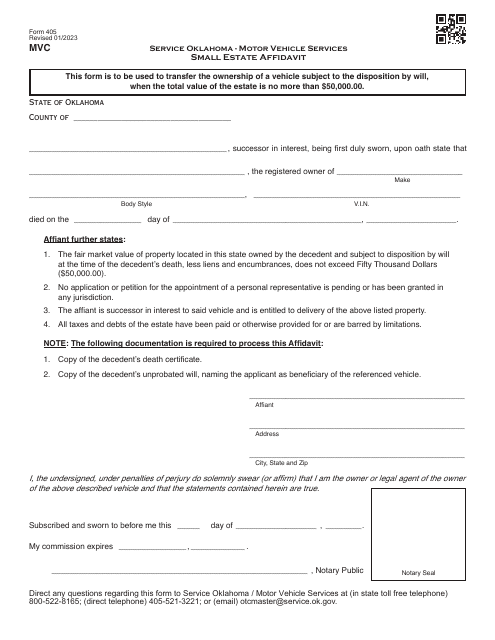Free Oklahoma Small Estate Affidavit Forms and Templates
Oklahoma Small Estate Affidavit Form: What Is It?
An Oklahoma Small Estate Affidavit refers to a legal instrument composed by the prospective heir of the individual that passed away in order to collect the latter's tangible and intangible property if the amount of the assets is not greater than the amount prescribed by the state. In case you know everything about the property the deceased person owned in life and believe you can be granted access to it quickly skipping time-consuming probate proceedings, this document will be indispensable for you as an affiant and beneficiary.
Oklahoma Small Estate Affidavit Types
- Form 405, Small Estate Affidavit. If the deceased individual owned a vehicle, the car can be transferred to the heir with the help of this document - file it with the local Motor Vehicle Division office. Confirm you are entitled to own it legally and attach a copy of the will that certifies the estate owner's wish to name you the beneficiary;
- Oklahoma Small Estate Affidavit Form. This is the main form you need to prepare when claiming the small estate of a deceased individual in Oklahoma. It means you exercise your right as the intended beneficiary while also saving time and money since you will be given access to the property you want to receive within days.
How to File a Small Estate Affidavit in Oklahoma?
Follow these steps to draft and file a small estate affidavit in Oklahoma:
- Check the current version of the state regulations that cover the settlement of property upon the death of its owner. At the moment, you have to wait ten days before formalizing the affidavit, the assets in question cannot exceed $50.000, and the authenticity of the document must be verified by a notary public who will put a notary seal under your signature. Also, you have to reach out to a local county clerk by calling them or visiting their office to find out whether a personal representative of the estate was appointed already.
- Complete the affidavit. Indicate the name of the county where the deceased person died, identify yourself by your full name, record the name of the deceased person and their date of death, list the assets and briefly describe them, sign and date the document. Make sure you contact a local notary public to finalize the affidavit - without a notary public's seal and signature, the form will be considered invalid.
- Once the form is prepared, you may present it alongside a death certificate to any individual or organization that holds the assets described in writing certifying your right to receive this property, and they will be obliged to transfer it to you. There is no additional need to notify local authorities or courts about the existence of the affidavit.
Documents:
2
This document is used for claiming an estate with a low value in the state of Oklahoma. It allows heirs to bypass the probate process for small estates.


